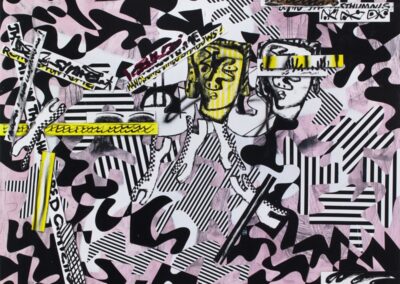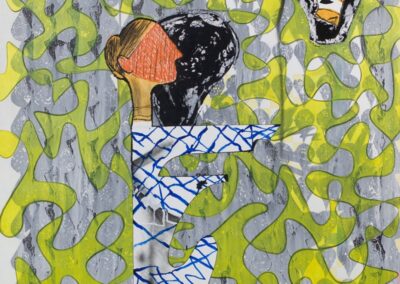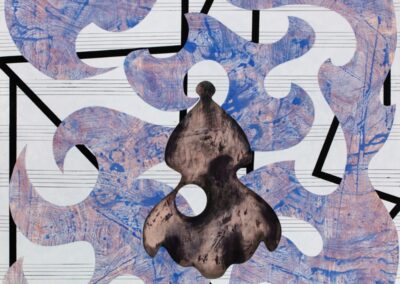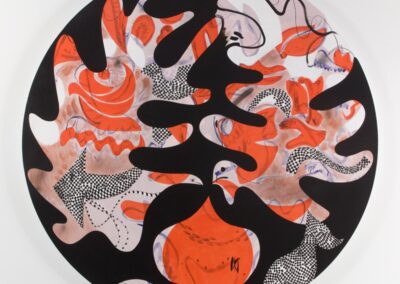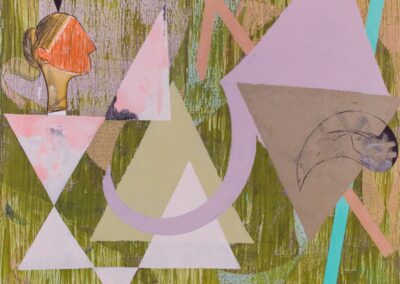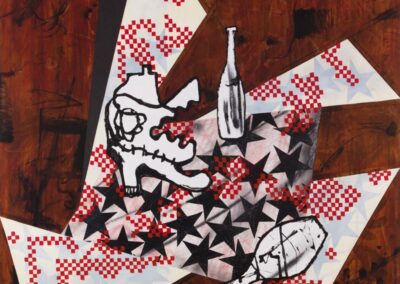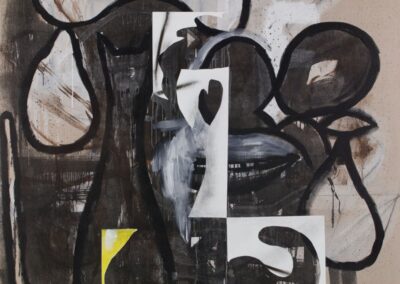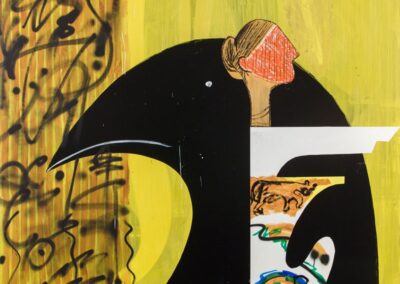ART WRITING
INTERVIEWS WITH ARTISTS
CHARLINE VON HEYL
The Language of the Underworld, 2017. Acrylic, charcoal on linen 90 x 108 inches. Courtesy the artist and Petzel, New York.
CHARLINE VON HEYL
Poetry Machine #2, 2018. Acrylic, charcoal and oil on linen. 82 x 74 inches. Courtesy the artist and Petzel, New York.
CHARLINE VON HEYL
Lady Moth, 2017. Acrylic and charcoal on linen, 90 x 82 inches. Courtesy the artist and Petzel, New York.
CHARLINE VON HEYL
Tondo, 2017. Acrylic and charcoal on linen, 80 inches diameter. Courtesy the artist and Petzel, New York.
CHARLINE VON HEYL
Poetry Machine #1, 2018. Acrylic, charcoal, and oil on linen, 82 x 78 inches. Courtesy the artist and Petzel, New York.
CHARLINE VON HEYL
Hero Picnic, 2018. Acrylic and oil on linen, 82 x 74 inches. Courtesy the artist and Petzel, New York.
CHARLINE VON HEYL
Do You Peeve Cato? 2017. Acrylic and charcoal on linen, 82 x 78 inches. Courtesy the artist and Petzel, New York.
Charline von Heyl with Raphael Rubinstein
The Brooklyn Rail, November, 2018
Breaking expectations, Charline von Heyl demonstrates that you can be an enthusiastic scavenger of bygone eras in art while producing paintings that look, and are, completely contemporary. If she borrows motifs and moves from various long-unfashionable artists who were trying to forge a new language of painting amidst a ruined and traumatized Europe following the Second World War, it’s not at the service of pastiche or irony: her work is too personal, and too sensitive to the present moment, for such pursuits. Born in what was then West Germany in 1960, von Heyl profited from exposure to various factions and options in the intensely competitive and keenly self-critical German art scene of the 1980s and ’90s. She studied with and worked for Jörg Immendorf in Hamburg and Düsseldorf, entered the milieu of Martin Kippenberger and Albert Oehlen in Cologne, and emerged there amid an international cohort of artists and critics that included Michael Krebber, Fareed Armaly, Cosima von Bonin, Andrea Fraser, and Isabelle Graw. This intellectually stimulating context was not very interested in the medium of painting. In the middle of the 1990s von Heyl moved to New York, a city that offered more scope to painters, and a less factional, ultimately more generous, art community. She now divides her time between New York and Marfa, Texas. The following conversation took place in her Brooklyn studio during a show of recent paintings at Petzel Gallery in New York and a few weeks before the opening of a traveling survey of her work at the Hirshhorn Museum in Washington D. C. Taking its cue from the presence of Emily Dickinson in some of von Heyl’s recent canvases, the discussion dwelt almost as much on poetry as it did on painting.
Raphael Rubinstein (Rail): Since you’ve been asked about your history extensively in past interviews, I’d like to focus instead on the recent paintings at Petzel. Three of them carry the title Poetry Machine, and in each of these there’s a woman’s head in profile. Whenever a figurative image appears in an otherwise abstract painting, our eyes go to it immediately, whether it’s a hand, a head, a face. And if it’s a face, we want to read the shapes near it as a body. That happens in the Poetry Machine paintings, even though the heads are only a small detail in the paintings. I know you don’t preplan your paintings, don’t do preparatory drawings, but I wonder if you always knew that these compositions would include a figurative element?
Charline von Heyl: Well, those are two very different concepts. At the beginning of a painting, it’s almost arbitrary what happens, but it stays abstract for a long time. It’s more about movement, shapes, and colors. As for drawing, I’m usually making a lot of drawings in notebooks to illustrate thoughts, or that could become thoughts by themselves. They’re often funny. Three years ago I started to incorporate drawing into painting. The drawings that I had done before in paintings were just outlines of shapes, so for me they stayed abstract. They were never anecdotal moves describing a head, or an eye, or a bottle, or whatever. Recently, I started to think that things would get more intense if the paintings had that factor of anecdote. I would make the drawings bigger and more painterly, cut them out, and move them over the painting to see where they would “land,” where they would enhance the painting. Then I would paint an exact copy of that drawing into the painting. And that’s when the heads started to appear. A head, or a pair of eyes, that looks back from a painting is a death sentence for a painting, so I tried to avoid that by either having a profile, or having the eyes covered, or making the head an object.
Rail: The women in the Poetry Machine paintings are faceless, almost like an ancient sculpture that has been worn away by time.
von Heyl: They have a wax crayon feel that is more about drawing than about a head. But as you said, a head completely transforms everything around it into a body.
Rail: It’s a little tempting to read those as self-portraits, the artist in her own painting. But they also evoke a bygone era.
von Heyl: When I painted them I was immersed in the work of Emily Dickinson and Virginia Woolf. The head has this very severe, straight-necked, bun-carrying, spinster feeling to it, and it is really the head of the Poetess. That’s also why they’re called Poetry Machines. It’s also like the head of a woman not as body. I wanted to get a woman into a painting without immediately talking about body.
Rail: There’s another large painting, not in the show, that’s going to the Hirshhorn, where lines from an Emily Dickinson poem, “Banish air from air,” fill a shape that’s vaguely suggestive of a human figure.
von Heyl: It’s actually the shape of a moth. A lot of things that I’m painting have to do with language. The moth, for example, is part of the word “mother,” and my mother just died, so the moth was appearing everywhere as a sort of reference to that. Also, because it is an animal drawn to the flame, and the stylized flame appears in many of my paintings. The moth shape has multiple references. Abstraction has actually a lot to do with that kind of ambivalence. Abstraction is not only about “no-meaning,” it’s also about imploding meaning. I like to have references to half-thought associations.
Rail: I see a parallel between your embrace of more recognizable images and your recent use of legible texts. The writing in your paintings used to be an illegible fluid scrawl, but now there is a perfectly readable Emily Dickinson poem. That looks like a really fundamental shift. You are saying unambiguously, “this is a head, this is a word, a poem.”
von Heyl: Except that particular poem is so abstract in itself. The image it provokes, when you read it, becomes another imaginary layer in the painting. I also have to say that that particular painting was made as a decoration for my studio. I very often have text on the walls of my studio, especially when I start a new body of work—as a kind of “motto.” The painting The Language of the Underworld at Petzel has writing all over it, but you cannot read any of it. That’s what usually happens to writing in the paintings. I find it works only very rarely that a legible text in the painting is not destroying a painting, just as a face in the paintings can destroy a painting. Maybe I was flirting with the death of painting by adding faces. [Laughter]
Rail: Speaking of which—and I mean death, not the death of painting—what about those death-head skulls in the corners of several canvases?
von Heyl: All the paintings in the show are infused with a kind of darkness. We are living in dark times, and that has seeped in. These feelings—of fragility, of helplessness, of sadness—that we are all experiencing have had two effects on me during the past few years. One is that I actually have a feeling of being able to dare more, because it feels like I need to throw myself against the wall. I need to do the stupid move that actually expresses my feelings. But also, it does the opposite, it shuts things, closes them down hermetically even more than usual. My paintings usually have a way of being closed in upon themselves, and that makes them maybe a little more intense. I just read that 76% of all flying insects in Germany are gone, just gone. Every day there seems to be something like that, a kind of news-bit that would have been a headline twenty years ago and would have made everybody cry out in pain and fear, and now we just eat it up in this weird way.
Rail: We’ve become numbed to evil and disaster, and look for anything that will make us forget or feel like we’re doing something positive.
von Heyl: As when we say, “plastic straws are bad” but still use eight plastic containers for our Chinese takeout food.
Rail: One has to live with contradictions
von Heyl: There’s a phrase, I don’t remember who said it, probably Marx: “Money replaces consciousness.” You see that over and over again now. It’s so evil.
Rail: I’m going to switch gears here, if it’s OK with you—
[Laughter]
von Heyl: Yes, we got into this dark thing! We can also edit it out.
Rail: There is one tondo in the show. I don’t recall seeing you make a tondo before.
von Heyl: No, that’s the first.
Rail: It’s notoriously difficult format. What inspired you?
von Heyl: I liked the idea of shaped canvases, but for that you have to have a specific idea to begin with, whereas a tondo is just like a square, it’s a circle. I was expecting it to absolutely re-set my formal approach, but the opposite was the case. I realized that every time I’m working with a square, I have to get out of my natural movements to think about the dead corners, and to integrate them. A circle is actually a much more natural way, if you start with this kind of ‘body dance.’
Rail: I have trouble looking at tondos sometimes, but I love the tondos of the Chilean-Italian painter Carmengloria Morales, and Shirley Jaffe did a few marvelous ones.
von Heyl: I went to visit Shirley in Paris once. I was always surprised that her work didn’t get more attention because I thought that she had, very early on, defined a vocabulary of shapes that I found very original and powerful, poetic. I went with Amy Sillman. It was memorable. She was over eighty, and was still living in this very Parisian, under-the-roof studio. It was very, very frugal, and she was making paintings that were just illuminating the space. The artist in the studio has always been an obsession of mine. For the artists of my generation it was kind of forbidden to indulge in—so I always indulged in it with extra verve. But always there was this feeling of being part of a stage set, or doing something that was decorative, and not necessary, even though I think in the end all those things are exactly necessary and haven’t changed. I think that artists need studios. But back to Shirley Jaffe, there was something about the precision of her setting up a painting, and the way that the painting really was an object that was created out of a surrounding for its own purpose. She seemed not linked to the art world, it really had something so pure that was reflected in the paintings. I think that’s a fantasy that we all have, but to see it lived was extremely touching.
Rail: Well, the sense of “the lived” is where it gets interesting. Shirley used to talk about the idea of “quelque chose vécu,” something that’s lived, when she tried to describe what her paintings were about. There are obviously distinct differences between her work and yours, but you both require the viewer to keep re-calibrating. Relationships never settle down. For instance, you are always inviting the viewer to think about the relationship of gesture to shape to pattern. It’s hard to say where one stops and the other starts.
von Heyl: That’s totally true. At the root of my painting is the line. As an outline, line defines a shape. In repetition, line creates pattern. Sometimes color just comes from filling in between the lines. The way I paint is not coming from a “painterly” way, even though it’s very painterly in the end. It comes from a much more graphic understanding of what can happen on a surface. It’s always the line that leads me to something. When I put color into my paintings, it’s almost always to enhance lines, or to erase lines, or produce effects that turn illustration into a painting. That’s also the reason why the paintings stay flat. I don’t use a vanishing point, and if I use perspective I use reverse perspective where things appear to fall out of the painting. The paintings never look to be more than five inches deep, but they also extend out toward the viewer. They all have the same structure. If you would want to look for a signature style, you could start there. I’m also interested in the way line is linked to language and culture. For instance, as a kid, I was influenced by a very German kind of illustration, the comic-grotesque drawings of Alfred Kubin and the like. Moody drawings that seem charged with something magical, unheimlich.
Rail: Do you mean the kind of feeling Freud talks about in his essay “The Uncanny”?
von Heyl: In Germany, there is a tradition of das Unheimliche in German literature and poetry, from E.T.A. Hoffmann to Christian Morgenstern. I’ve never lost this feeling for language as something that can be as secretive and as eerie as painting.
Rail: You’ve said somewhere that you want the paintings to be “ahead of language.”
von Heyl: Yes, that’s true, but I was not talking about language as poetry and mystery. That’s something completely other.
Rail: As a poet I’m interested in your engagement with poetry. It reminds me of what poems can do in response to art that is different from art criticism or art history. A poem can describe the actual contingent personal subjective experience of looking at a painting, which usually involves all kinds of “irrelevant” mental activity. When you’re looking at a painting in a gallery or museum, part of your mind is thinking about what you’re going to have for lunch, whether you put enough money in the parking meter, who is that attractive person who just walked into the gallery. All these things that have nothing to do with the paintings but that belong to the experience of the work, all the stuff that gets left out of art criticism and art history, which try so hard to be objective.
von Heyl: When I think about poetry in relation to painting, I think about the Objectivists and the Language poets, and also Gertrude Stein. They all insist on a poem being as much a fact or an object as a description and manage to break language open to a network where it barely holds content. I know how complicated and self-negating a painting can be as it works to create different pressures of speed or silence or chattiness, in a way that is visual and emotional. How it works in a poem is different because a poem needs a different time line of being read, and will still always have a story. I insist in a similar way on my paintings being objects as much as events.
Rail: Given your interest in poetry and language, and your thinking about how painting works, I’m surprised that you don’t do any writing. I read a lot to prepare for this interview, and I didn’t come across a single artist’s statement or essay by you. So many artists write, maybe even most of them these days. Why not you?
von Heyl: The act of writing paralyzes me, but I don’t mind talking about my work. I like reading critical theory but strangely enough I often get more as a painter from literary criticism, from poetry criticism, than from art criticism. If you put the word “painting” where it says “poetry,” there’s a lot to learn.
Rail: The fact that you don’t write criticism or make artist statements means you are totally focused on one thing: you’re a painter and what does a painter do? A painter makes paintings. That’s very far from Martin Kippenberger’s concept of the “total service artist.” For every one of his shows he would make an artist’s book, design a poster, design an ad, give a speech at the opening. He also organized shows, collected art, held court in bars and restaurants. He believed that it wasn’t enough just to make art—artists should assume responsibility for every aspect of their career. You don’t seem to do that.
von Heyl: No. Kippenberger always needed to prove something to somebody. To be better than Albert [Oehlen] or to make a point about something. It had to do with hierarchy, it had to do with power, it had to do with social influence, and that’s not something I‘m interested in. I fight mostly against myself. Although I have to say that I love giving speeches and I do it as often as I can. I’ve also done my share of artist books and I do actually design ads and posters for my shows.
Rail: I want to ask you about your engagement with the decorative. The paintings are full of stripes, stars, checkerboard patterns, repeating Baroque motifs. Does this have anything to do with Matisse or the Pattern & Decoration movement or Daniel Buren?
von Heyl: My interest in pattern comes from things like art deco, fabric design or actual wallpaper. But I’m also interested in artists like Bernard Buffet who used the line explicitly as style, and other artists who were considered too mannerist to be actual great artists because they used a signature style in a decorative way.
Rail: I know you have cited Buffet before, but I think you work may have more in common with another often-shunned French painter, Georges Mathieu.
on Heyl: Mathieu is a good example for taking on stylistic vocabularies that are linked to failure. Another example is Serge Poliakoff, whom I love because there is something always off with his paintings. The way his shapes are always a little too heavy and a little too tight might open something up in a painting that needs a counter-weight.
Rail: By recuperating these kinds of marginal figures you are rewriting art history for your own needs, which is what every ambitious artist does. As T.S. Eliot said, when a new work of art is created, something “happens simultaneously to all the works which preceded it.”
von Heyl: That’s a great quote. But not everything is about art history. I always have stacks and stacks of books beside me, and there is a visual cannibalism that actually skips art history. It’s not mediated through a desire to quote something for a reason, it is because I just need that particular move. I can mix Poliakoff with moves that come out of Uccello, who also uses shapes, and puts them together too tightly. It’s an emotional cannibalism of visual components. Art history has nothing to do with that.
Rail: I love the phrase, “emotional cannibalism”! I’ve been wondering why you are so drawn to German and French abstraction of the immediate postwar period, to artists like Poliakoff, Wols, Werner Heldt, Willi Baumeister. Isn’t this the kind of art that was rejected by the German painters that preceded you, the generation of Richter and Polke? In true Oedipal style, did you have to kill your artistic parents, and then befriend your artistic grandparents? By jumping over that generation of the ’60s and ’70s, by going back to what they had rejected, you found something you could use.
von Heyl: But that kind of goofy abstraction is what was in the museums when I was a child. I would go into the museum and there would be Wols, not Polke.
Rail: That was your first inspiration, your first discovery of art?
von Heyl: Yes, in the same way as a certain kind of kitsch, which was my idea of beauty when I was a child. I was already then trying to own everything that I was wanting visually. When Polke came into the game it was already mediated, it was already drenched in irony, it was already political. It was not as raw as this desire I had with The Blue Phantom of Wols.
Rail: So emotion is really important to you, without having to be an expressionist?
von Heyl: Desire. Visual desire. It’s a desire for power. It’s a desire for having as many tools and possibilities as possible. I am not somebody who has ever been able to think long and deep. I am always skimming, always skipping. This mental restlessness is something that the paintings are built of. I am always looking, there’s a constant hunger for images. For the images I haven’t painted yet. Being here, now, in the studio, with ten white canvasses with not a single stroke on them, to me is frightening but at the same time the potentiality of it enhances my own future self.
Rail: You’ve named one painting, Igitur, after a Mallarmé text and your traveling survey that’s opening at the Hirshhorn next month is titled “Snake Eyes,” which has to do with dice, so it’s impossible not to think of Mallarmé’s typographic experiment, Un coup de dés jamais n’abolira le hasard (A throw of the dice will never abolish chance). Here’s how I would apply it: making a new painting, putting a new object into the world, means that there is still an infinite number of paintings to be made. Unlike some other painters, you don’t do minor variations on a theme. At each roll of the dice everything is still possible. You make a painting and that doesn’t effect or limit what the next painting can be. Mallarmé also has something to tell us about the relationship between idea and material. Before you start, you might be thinking “I’m going to make the greatest painting I’ve ever made,” but once the dice are rolled, you have this recalcitrant stuff to grapple with.
von Heyl: I don’t think hierarchically like that. I never think, “I’m going to make better paintings,” I just think, “I’m going to make another painting.” I just want to make something that I haven’t seen before. Not to prove a point.
Rail: It’s not a competition with yourself or with anyone else?
von Heyl: No, it’s not. And I’m saying that slowly because when you say the word “competition,” it does ring a bell somewhere, so I’m probably lying. But I always want the next painting to have something to do with me and at the same time be utterly strange and “other.” I find it fascinating that something I do not understand can be created by me.
Rail: That means allowing for the unexpected, as when Malcolm Morley seriously messed up his gridded copy of Raphael’s School of Athens and left the mistake in the finished painting. I know you’ve cited this as an inspiring model for how you work.
von Heyl: I try to trick my paintings into happy accidents. The strongest paintings are the ones that I pushed to a point where they got completely stuck, and then a half year later I just turn them around and do something different with that kind of pathetic materiality. The paintings contain a fluid sort of manifestation of mere skill, which I can also do, but that only goes so far. It’s when the wheels grind to a halt, when the painting gets sabotaged, that it starts to be interesting. “Sabotage” literally means throwing a wooden shoe, sabot in French, into the wheels of a machine to destroy it.
Rail: Can you give me an example of a painting in the Petzel show where something like that happened, where you sabotaged yourself?
von Heyl: All three of the Poetry Machine paintings had been around the studio as total failures for a long time. One of them for maybe three years. The sabot I threw into them were the heads.
Rail: I noticed that in at least one of the paintings you include a painted image of a stencil. I don’t know if you used a stencil to create an image of a stencil but if so it would be a nice piece of conceptual tautology. Maybe not the sort of thing one expects from a painterly painter.
von Heyl: Obviously I’m a painter, I’m thinking about painting, I’m in a painterly studio, I have painterly clothes, I’m doing painterly moves, and still the distance between me and the paint is just too abysmal that I could full-heartedly say “I’m a painterly painter.” I’m not a fetishist when it comes to paint. My approach to it is much more pragmatic. It almost makes me feel like I’m cheating sometimes. For instance, I use oil color with the acrylic but I use it the same way I put crème fraîche into a stew to enhance the flavor. There’s no mystery to it.
Rail: I notice a lot of still-life elements in your paintings. The genre of still life was crucial to Cézanne and the Cubists, it was at the heart of radical modern art, which is kind of paradoxical if you think about it, but since then, except in the work of a few Pop artists, its been pretty marginal. What attracts you to still life?
von Heyl: To me still life is interesting because I see it as something that’s neither abstract nor representational. Because it is so formulaic, it doesn’t matter if it’s a bottle or a plate or an apple, those are just signifiers that hold the painting. I’ve learned things from Bernard Buffet, who would put three or four of his super sad little shapes, like planets in space, completely forlorn and without shadow, without perspective, basically just drawings, in a painting. You’re not interested in what kind of bottle or what kind of bread it is. It is the flat-out vocabulary of painting, the same way as blue or yellow.
Rail: And there’s no reason not to paint bottles or bowling pins.
von Heyl: They’re just shapes!
Rail: Your paintings remind us how we’ve superseded the binary between figuration and abstraction. It’s no longer a viable way to think about painting.
von Heyl: Exactly. That’s why I love Juan Gris’s late paintings. They are just glorious, an absolute high point of painting. He is utterly decorative compared to Braque and Picasso’s complicated sophistry. There’s an absolutely luminous unfolding of shapes and colors. It’s almost a kind of Pop Cubism. But without the still life elements, it would fall apart. I also love Gris because his work is such a celebration of composition and I’m a complete, total sucker for composition, obviously.
Rail: The visual world you create has decorative qualities, and the joie de vivre of pure line and color, but as you were saying in the beginning, there are darker intimations that drift in. Your paintings are impure and open to contradictory impulses. They argue with themselves, and that invites the viewer into the argument. There’s an openness in your work, which is partly because of your stylistic diversity, but also because you’re never sure what the painting is going to end up being about.
von Heyl: Right, so I always have to cut openings into the painting so that it can breathe again, because every move that celebrates the painting’s perfection is also suffocating it. Destruction and perfection go hand in hand. I like the way that you say my paintings are “impure.” I like when extremes meet. I think the motto for my next body of work will be “creative indifference.” As a charged fetish object for the studio, I just bought a signed first edition of a book by this interesting figure, Salomo Friedlaender, who also wrote under the name Mynona, which is anonym in reverse. He believed that there is a power that can emerge in the tension between two extremes, like very evil/very good, very beautiful/very ugly, or very smart/very stupid. It is in that moment where he finds “creative indifference.” I don’t fully understand him yet, but I find that idea fascinating, and the fact that he was filling ten volumes with philosophy and at the same time writing these comic grotesques and running around Berlin in drag during the 1920s, showing the two extremes in his own personality. So now I’m thinking, “Okay, that’s where I start next” without actually know where it’s going to lead me. Just that phrase “creative indifference” already means something to me.
Rail: “Creative indifference,” it sounds a bit like John Keats’s “negative capability.”
von Heyl: I think you’re right. That’s totally true.
Rail: I can’t wait to see what “creative indifferent” paintings you end up making.
